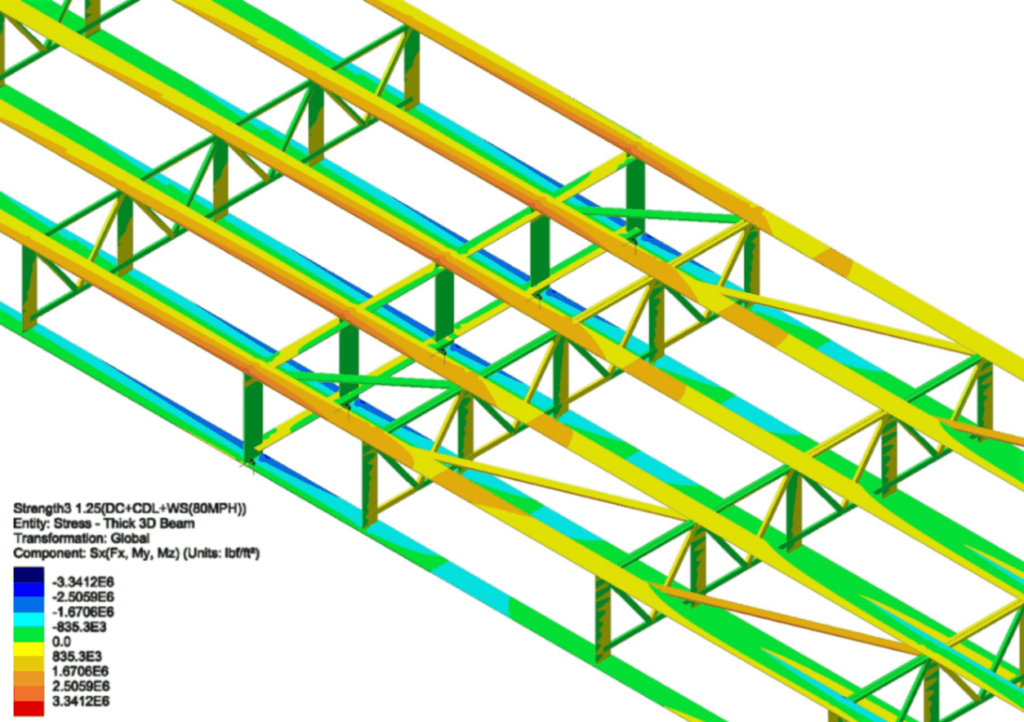 Courtesy of Iowa Department of Transportation
Courtesy of Iowa Department of TransportationThis article is partially derived and excerpted from NCHRP Synthesis 620: Quality Processes for Bridge Analysis Models and a University of Toledo online news feature about the report.
The design of bridges often involves the use of structural analysis models of varying degrees of complexity. These models range from approximate one-dimensional line girders to sophisticated two- and three-dimensional finite element analysis models. A variety of analysis methods and software can be used to create and analyze these models. This process can be quite complex, as it uses a large number of input parameters and generates significant amounts of output data. Figure 1, for example, shows the stress contours obtained from the finite element analysis of the NE 54th Avenue Bridge (above).
Engineers must understand the limitations of the analysis method and software, possess experience in developing analysis models with appropriate approaches and assumptions, and correctly interpret the results. An appropriate understanding of the expected behavior of the structure is also required to assess whether the predicted behavior represents the actual performance of the structure. A simple check of the program input values is not an adequate method of ensuring the accuracy and validity of these models.
 Courtesy of Iowa Department of Transportation
Courtesy of Iowa Department of TransportationTo document state department of transportation (DOT) practices related to the quality processes for bridge structural models, the National Cooperative Highway Research Program (NCHRP) established a project panel under NCHRP Synthesis Project 20-05/Topic 54-11, “Quality Control Checks for Bridge and Structure Analysis Models”, which produced NCHRP Synthesis 620: Quality Processes for Bridge Analysis Models.
Information for the synthesis was collected through a literature review, a survey of state DOTs, and follow-up interviews with five selected state DOTs for use as case examples. The survey was completed by all 50 state DOTs and the District DOT, yielding an overall response rate of 100 percent. Detailed case examples were developed for California, Colorado, Iowa, Louisiana, and New York DOTs.
The result is more than 100 synthesis pages that explore the quality processes for bridge analysis models among state DOTs ranging in size from fewer than 10 to more than 80 in-house bridge engineers. The report parses responses to questions about written and informal processes for the following areas:
- Identifying appropriately qualified staff, including in-house personnel and consultants;
- Choosing an appropriate analysis method and software;
- Validating the analysis software;
- Modeling a bridge structure with proper approaches and assumptions;
- Verifying the analysis results; and
- Reconciling discrepancies between independent models.
The report concludes by identifying current knowledge gaps, along with suggestions for future research to address these gaps. The most obvious research opportunity is to develop guidelines on effective quality processes for bridge structural analysis models—specifically on complex models such as the finite-element and strut-and-tie models. The report also suggests developing a standardized system of advanced training for engineers in finite-element and strut-and-tie analysis, as well as seminars or training courses for engineers on commonly misunderstood concepts such as verification, validation, uncertainty, error, and calibration.





